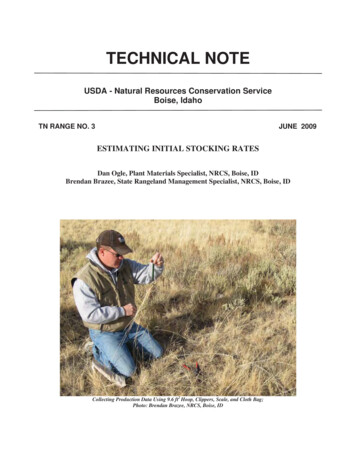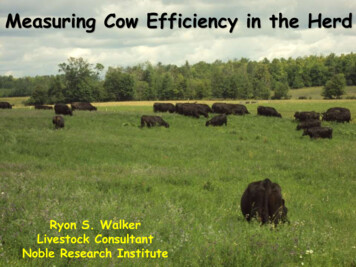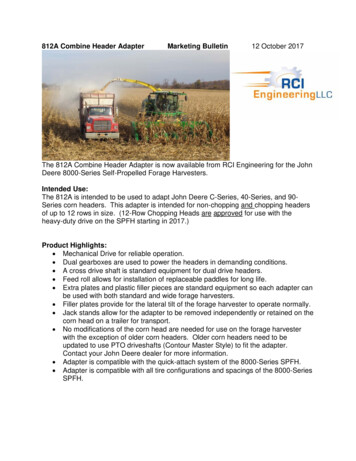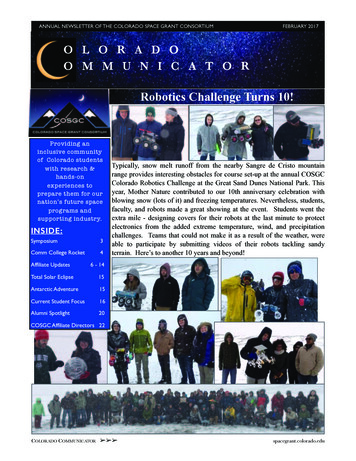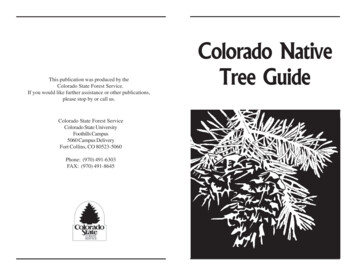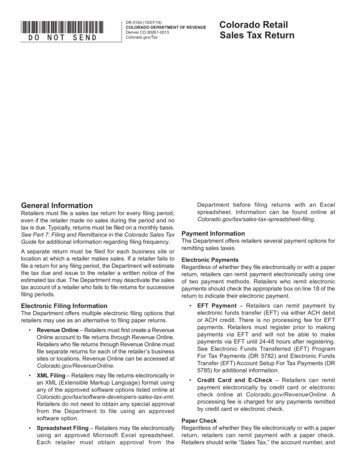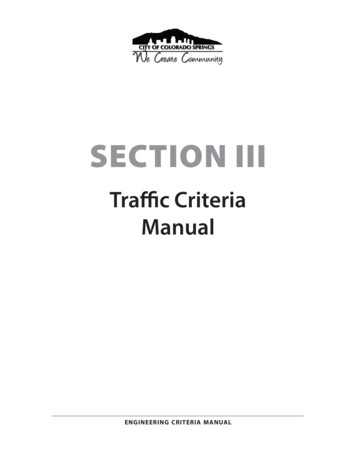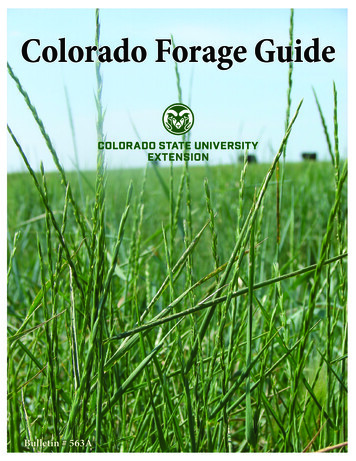
Transcription
Colorado Forage GuideBulletin # 563A
Colorado Forage GuideJennifer L. CookJoe E. BrummerPaul J. MeimanThaddeus GourdAdapted from the Forage Guide for the Northern Colorado Front Range, by Ron Jepson, Colorado State UniversityCooperative Extension, 1997Grazing Lands Conservation InitiativeBook design and layout by Chris UhingSpecial thanks to Sharon Bokan, Ginny Price, and Ron Jepson for their review of this document.Photo and illustration credits:Jennifer Cook, front cover photo of slender wheatgrass, figures 6, 8, 25Ellen Nelson, figure 7Living on the Land curriculum, figure 9Pasture and Range Plants, Phillips Petroleum Company, 1963, figures 2, 10–13, 15-19, 21, 23, 24, 28, 29, 31-35Guide to Grasses, Pawnee Buttes Seed, Inc., figures 14, 20, 22, 26, 27, 30Contributing authors and editors:Jennifer L. Cook, Small Acreage Management Coordinator, CSU Extension/NRCSJoe E. Brummer, CSU Associate Professor/CSU Extension Forage SpecialistPaul J. Meiman, CSU Assistant ProfessorThaddeus Gourd, Adams County Extension DirectorIssued in furtherance of Cooperative Extension work, Acts of May 8 and June 30, 1914, in cooperation with USDA-NaturalResources Conservation Service, Colorado State University Extension, and Grazing Lands Conservation Initiative. AllExtension programs are available without discrimination. No endorsement of products mentioned is intended nor iscriticism implied of products not mentioned.Updated June 2018
CONTENTSIntroduction1Wheatgrass, Western 26Wildrye, Russian 26Pasture Renovation1Site Considerations 1Bunch and Sod-Forming Grasses2Warm- and Cool-Season Grasses3Native and Introduced Grasses3Legumes 3Solo and Mixed Seedings4Plant Varieties 5Buying Seed 5Species Suggestions 5Pure Live and Bulk Seed6Designing a Seed Mixture6Legume Species and Varieties 27Alfalfa 27Clover, Red 28Clover, White 29Milkvetch, Cicer 29Sainfoin 30Trefoil, Birdsfoot 31AppendicesAppendix A: Species Suggestions for Various Sites 32Appendix B: Characteristics of Grasses34Appendix C: Characteristics of Legumes35Appendix D: Seeding Rates for Selected Pasture Plants 36Plant Establishment 7Soil Testing 7Seedbed Preparation 8Seeding Methods 8Time of Seeding 9Early Stand Management 9Grazing Management 9Overgrazing 10Grazing Management Guidelines11General Pasture Management Guidelines 13Ungrazed Pastures 14 Sources of Additional Help 14Grass Species and Varieties 14Bluegrass, Kentucky 14Bluestem, Big 15Bluestem, Little 15Bluestem, Sand 16Brome, Meadow 16Brome, Smooth 17Fescue, Tall 18Grama, Blue 19Grama, Sideoats 19Indiangrass, Yellow 20Needlegrass, Green 20Orchardgrass 21Sacaton, Alkali 22Sandreed, Prairie 22Switchgrass 22Wheatgrass, Crested 23Wheatgrasses, Intermediate and Pubescent 24Wheatgrass, Newhy 25Wheatgrass, Tall 25Wheatgrass, Thickspike 25ii
INTRODUCTIONThe number of small acreage tracts continues to increase throughout Colorado. Owners of these tracts have a variety ofgoals for use of their land, including: wildlife habitat, enjoyment of open space, farming enterprises, livestock grazing,greenhouse crop production, forestry, and horticultural activities. Tract owners vary in their levels of expertise inunderstanding the land and how to manage its resources.This publication was produced to help small acreage landowners become familiar with livestock forage and grazingmanagement. Information is provided on how grasses differ, what legumes are and how they can fit into pastures, andwhat to consider if you need to revegetate your pasture, including how to design your own seed mix. The section ongrazing management will help you know what to look for and expect before, during, and after your pastures are grazed.Because grazing is an ongoing learning process, this information will complement your own experiences and the adviceof others, such as Colorado State University Extension (CSU Extension), the Natural Resources Conservation Service(NRCS), and neighbors.In the “Grass and Legume Species and Varieties” sections of this publication, plants that can be used for forage in thevarious regions of Colorado are listed in alphabetical order. Each plant is described briefly, including its site adaptations,advantages and disadvantages, and its potential for use as hay or pasture. On most small acreages, buying hay is moreeconomical than on-farm production.PASTURE REVEGETATIONRevegetating pastures can cost over 100 per acre, so it is something you do not want to do over and over again. First,evaluate whether the pasture really needs to be revegetated. On many small acreages, overgrazing has caused deteriorationof rangeland or pasture condition. However, if there is enough desirable vegetation remaining in the pasture, then perhapsthe pasture can be restored without reseeding. Restoring your pasture may be as simple as deferring grazing for a year ortwo to allow grass recovery time, controlling undesirable vegetation, and then implementing a rotation grazing system withproper carrying capacity. These grazing management practices are discussed in the Grazing Management chapter.Revegetation is expensive, requires a number of years to become fully established, may increase erosion and weedproblems, and there is no guarantee the conditions will favor establishment. Established pastures will last a lifetime ifproperly managed. Proper management includes selecting the right forage species for your site and intended land use,purchasing quality seed, preparing a good seedbed, using appropriate seeding methods, and following proper pasturemaintenance techniques. It also includes proper water management on irrigated pastures and attention to weed control,especially of noxious weeds like Canada thistle. On dryland pastures, timely precipitation is needed to establish newseedings. Unfortunately, pasture managers have no control over the weather. As a result, some dryland reseedings will faildue to dry winters and springs, and another revegetation attempt will be required.Site ConsiderationsThe process of revegetating a pasture starts by analyzing the site environment, such as its topography, soils, and amountof water it receives. Soils are the foundation and nutrient source for plants. Soil texture is a measure of the proportion ofsand, silt, and clay in the soil. Plant species grow best on specific types of soil textures. For example, western wheatgrassis adapted to clay soils, prairie sandreed to sandy soils. Check with your local Natural Resources Conservation Service(NRCS) office to see a soils map that identifies soil textures of your land. A soils map of your land can also be created usingthe online NRCS Web Soil Survey located at http://websoilsurvey.nrcs.usda.gov/Loamy soils provide the best medium for forage plant establishment; they have a balance of sand, silt, and clay particles.Plant establishment on sands can be difficult because precipitation may not be adequate to keep water near the soil surfacefor establishing roots. Once plants are established on sands, however, they produce more forage than any other drylandsite. Clay soils tend to pack hard and plants will not establish easily if the soil surface is not loosened by mechanicalcultivation prior to seeding.1
Soils with a high salt content are known as saline soils. These have an electrical conductivity (EC) of 4.0 mmhos/cmor greater. Those with an EC of 12 or greater will support just a few forage species, such as tall wheatgrass, pubescentwheatgrass, alkali sacaton, and Russian wildrye.Electrical conductivity is determined from a routine soil analysis conducted by soil testing laboratories. The greater the ECof a soil, the greater seed germination is inhibited and plant growth is retarded. No forages will grow on soils with an EC of30 or more. For more information on saline soils, read the CSU Extension fact sheet no. 0.521, Diagnosing Saline and SodicSoil Problems.A small acreage pasture owner needs to know their intended land use before soil is revegetated. What kind of livestockor wildlife will graze it? If the pasture isn’t grazed, do you want short grasses that require little or no mowing? Will thepasture be intensively managed for grazing? Will the forage be harvested for hay? The proper selection of forage speciesdepends on answers to these questions.Finally, forage species are selected based on how much water the site receives. Dryland species are needed for sites thatreceive only natural precipitation. A difference of only 2 inches of average annual precipitation is enough to change thespecies that will survive the best. Sites receiving 12 inches or less of moisture are limited to Russian wildrye and certainvarieties of crested wheatgrass. Thickspike wheatgrass does better in areas receiving 12 to 13 inches of moisture than willits closely related cousin, western wheatgrass. Grass species options increase as precipitation rises above 14 inches per year.Some pastures are subirrigated when underground water is within reach of plant roots. These sites are often near rivers,creeks, canals, or ponds. They are more productive than dryland sites and should be seeded with forage species that takeadvantage of the extra available water.For irrigated pastures, determine how much irrigation water isavailable. Pastures are short of water if one or two irrigationsare made in the spring and no (or limited) water is available inthe summer. Different species are recommended for short-waterversus adequate-water situations. Be sure to check the quality ofyour irrigation water by having it analyzed by a lab. The amountof salts and nitrates are of particular concern.Bunch and Sod-Forming GrassesGrasses differ in their growth habits; they are either bunchgrassesor sod-formers. Bunchgrasses exhibit a growth form that istrue to their name; they grow in bunches or clumps. Crestedwheatgrass and orchardgrass are examples of bunchgrasses.Figure 1: Rhizomes and roots of western wheatgrass.Bunchgrasses typically have more leaves than sod-forming species. Many have leaves grouped near the plant base.Bunchgrasses typically produce more forage than sod-formers, but often need more intensive grazing management tooptimize productivity. For example, the growth of some bunchgrasses is set back when their developing seed stalks aregrazed. Some species raise their seed stalks earlier during the growing season than do others. However, some bunchgrassspecies such as orchardgrass, perennial ryegrass, and meadow brome continually initiate new tillers and their production isimpacted little by defoliation.Sod-forming grasses have underground stems, called rhizomes, which run parallel to the soil surface. Rhizomes tie the soiltogether and form a sod. New above-ground shoots are sent up from nodes located at regular intervals along the rhizomes.These shoots tend to fill in and cover bare spots on the soil. Examples of sod-formers are Kentucky bluegrass, westernwheatgrass, and smooth brome.Pastures dominated by sod-formers are not as rough as those dominated by bunchgrasses. Sod-formers typically are not asproductive, but often are more grazing tolerant than bunchgrasses because they can send up new shoots from rhizomes. Ifwell managed though, sod-formers like prairie sandreed and sand bluestem will out-produce most bunchgrasses.2
Warm- and Cool-Season GrassesGrowth rateCool-season grassesSome grasses grow best when the weather is cool whileWarm-season grasses others grow best when it is hot. Cool-season grassesgrow best in the cool, moist months of spring. Withadequate moisture, they will regrow in the fall. Theytypically go dormant in the heat of summer; however,some continue to grow with adequate moisture.Orchardgrass is an example of a cool-season grass.Warm-season grasses do not begin growth until aboutmid-May when soil temperatures reach 60 F. Theyare adapted to the hotter temperatures of summerand go dormant in the fall. Blue grama and the variousJan Feb Mar Apr May Jun Jul Aug Sep Oct Nov Dec bluestems are examples of warm-season grasses.Native and Introduced GrassesThe most commonly available forage grasses are either native to North America or introduced from another country.Native grasses evolved with the climate and soils of the area. They typically live longer than introduced species and requirelittle maintenance. They have the disadvantages of being more expensive per pound of seed and needing three to fouryears to establish before being grazed.Introduced grasses evolved outside of North America and were brought here for their forage qualities. They establish fasterthan natives and can be ready for grazing within one to three years. Russian wildrye is an exception; it can take up to fouryears to establish. They respond better to fertilizer and irrigation than natives, and seed costs are lower. Introduced grassesmay not have the longevity of native grasses.Choosing between native and introduced grasses may come downto a personal preference. A wide selection of species exists fromeach origin. On extremely dry sites, the introduced ‘Hycrest’ crestedwheatgrass may be the best choice to ensure establishment. Foradequately irrigated pastures, introduced grasses have the highest yieldpotential.LegumesLegumes, such as clover, are broad-leafed plants (forbs) that havecertain bacteria living in nodules (knots) on their roots. The bacteria(Rhizobia spp.) convert nitrogen from the air into a plant availableform. This “fixed” nitrogen is provided to the legume plant withsmall amounts becoming available to any grass plants growing in thestand over time. Each legume requires a specific species and strainof Rhizobia for nodule formation. The nodulation process is insuredby inoculating legume seeds with the appropriate Rhizobia beforeplanting.Mixing legumes and grasses in a pasture can increase total forageproduction by 30%. This response is dependent on adequate soilmoisture and varies with the species of legume. Alfalfa usually fixesthe most nitrogen; clovers and other legumes fix somewhat less.Figure 2: Principal parts of a grass plant.3
Growing grasses and legumes together improves the seasonal distribution of forage. Legumes can make more growth inthe summer than cool-season grasses. The addition of legumes usually improves the forage quality factors of palatability,digestibility, and nutrient content. The use of a less palatable legume like cicer milkvetch will have less of an impact onoverall forage quality.Solo and Mixed SeedingsSmall acreage pastures can be reseeded to a single species (solo planting or monoculture) or a mix of species. Mixturesare more ecologically desirable because of stand diversity. They survive disease and insect problems better, and extremesin climatic conditions. Mixtures are more efficient users of available moisture, light, and nutrients through the growingseason. An established stand of multiple species can be expected to provide better competition against weeds.Mixtures can include various combinations of grasses and legumes. Mixing warm- and cool-season grasses, however, isnot advised. While such mixtures will extend the grazing season of dryland pastures (less so on irrigated pastures), theyare best seeded in separate pastures for ease of management. Use the cool-season pasture in the spring and again in thefall (moisture permitting). Use the warm-season pasture in the summer. These separate pastures may not be reasonable toestablish and manage on small dryland parcels.Mixed stands of cool- and warm-season grasses often become dominated by the cool-season species over time. The coolseason grasses get first use of spring moisture and nutrients; whereas warm-season grasses use whatever moisture is leftover. Summer rains may be of little benefit as they are often inconsistent in timing and amount. Warm-season grasses willdominate if the cool-seasons are continually overgrazed in the spring.Mixtures of native and introduced grasses are not advised because the introduced species will out-compete the natives.Mixtures of native species, on the other hand, interact well and are recommended. Make simple mixtures comprised ofthree or four species for irrigated pastures. Including more species is common for dryland situations. Mixtures may beuseful where water tables, salt concentrations, and soil textures are variable. Each species will establish on the microsite towhich it is best adapted.Advantages of grass-legume mixtures are discussed in the “Legume” section of this publication. Legumes grow best withshorter and less aggressive grasses. If grass-legume stands are grazed by cattle or sheep, keep the percentage of legumesthat cause bloat to 25% or less. These legumes cause gases to build up and become trapped in the rumen and can leadto rapid death. Bloating legumes are alfalfa and the various clovers. Grazing of mixed grass-legume stands requiresparticular attention to grazing management. Legumes often are preferred by livestock and will be grazed out of the pastureif not provided the opportunity to regrow sufficiently.Mixed stands should have species similar in palatability (the degree of being desired by livestock), regrowth ability, timeof maturity, and competitiveness. Livestock will favor and overgraze the more palatable species in unbalanced mixes.Balanced mixtures foster optimum forage quality when harvested for hay.Dryland and irrigated pasture mixes are available on the retail market. These often contain combinations of nativeand introduced grasses, including perennial ryegrass. On dryland, the rapidly establishing ryegrass competes with theother grasses for water and nutrients, and then dies in three or four years. Select a mix of species adapted to the site andintended land use. Expect to pay a premium price for seed orders of less than 50 pounds.While mixtures have their advantages, monocultures might be appropriate in some situations. Crested wheatgrass andRussian wildrye provide forage two to three weeks earlier than other grasses. They are best managed as monocultures.Pubescent wheatgrass and smooth brome work well as solo plantings. Tall fescue should be solo planted. Monoculturesare easier to manage for forage regrowth rate and differences in palatability between species.Whether you go with a mixture or monoculture, a primary rule is to select species adapted to your site and intended landuse. Consult your local CSU Extension or NRCS office for assistance in selecting forage species.4
Plant VarietiesA list of varieties (cultivars) is provided with theindividually described plant species in this publication.A variety is a particular selection of a plant species(for example, ‘Fairway’ crested wheatgrass) thathas distinct, improved characteristics because of aslightly different genetic make-up. Varieties will breedtrue and reproduce themselves from generation togeneration. Examples of improved characteristicsare: quicker establishment, increased seedling vigorand plant productivity, pest resistance, and droughtFigure 4: Example of a seed tag.tolerance. Varieties in this publication are listed more orless in order of preference, but site and situation will influence variety selections.Buying SeedState and Federal laws require seed dealers to label all seed offered for sale. The label must list seed origin, purity, speciesidentity, percent germination, and weed seed content. It also must list the seed lot number and the company or personresponsible for label content.Origin. All seed lots offered for sale in Colorado must have the state of origin listed on the seed tag. If the origin isnot known, that fact must be stated. Be cautious of buying seed of unknown origin. The closer the seed origin is to thelocation where it will be planted, the better.Purity. Purity is the percent of the seed bag content that is seed from the desired species. Purity inert matter weedseed other crop seed percentages must add up to 100%. Inert matter includes small sticks and stems, chaff, and infertileflowers. Most grass seed should contain no more than 10 to 15% inert matter or it will be difficult to plant. However, somenative grasses like the bluestems, gramas, and Indiangrass will have higher inert matter percentages because they are hardto clean. Drills with seed-box agitators are needed to plant these seeds.Weed Seed. The label should indicate that no prohibited noxious weed seeds are present. For other weed seeds, ColoradoSeed Law states that they cannot total more than 2% by weight.Germination. Total viable seed includes the percentage of all seed that germinates in a lab analysis, plus the amount ofhard and dormant seed. Species vary with regard to the amount of hard and dormant seed. Do not consider these seedsundesirable; the higher the total germination, the better. Germination for most grass species should not be lower than60%. Germination of chaffy seeds may be lower.Species Identity. Forage seed is sold as Common, VNS (Variety Not Stated), or Certified. Certified seed is the mostexpensive of the three, but guarantees the variety that you order. It is sold in bags with a blue tag. When certified is notavailable, purchase seed of verifiable plant varieties. Some VNS seed may be from a high-quality blend (mixture of two orthree) of varieties. Verification is the key. When neither certified nor verifiable seed varieties are available, purchase seedof known origin and adaptation to your area.Species SuggestionsGeneral species suggestions for various sites are listed in Appendix A. Every pasture site is unique in its soils, topography,microclimate, moisture availability, and intended land use. Your site description may not be listed in Appendix A. Beaware of which species combine well together and which ones are best seeded as monocultures. Also focus on whether theforage will be grazed by animals or harvested for hay. Once you select a species or mix of species, choosing an appropriatevariety becomes the next important decision.5
Use Appendix B: Characteristics of Grasses, Appendix C: Characteristics of Legumes, and the individual speciesdescriptions in this publication to help you make selections. Seed cost and availability may affect which species compriseyour final mix.Pure Live and Bulk SeedBecause of differences in purity and germination between seed lots, seed is purchased on the basis of Pure Live Seed (PLS).PLS is figured by multiplying seed purity by seed germination. Use the decimal representation of a percent (proportion)when figuring bulk seeding rates. In other words, 70% purity equals 0.70.Planting based on PLS seeding rates ensures that you plant the number of seeds of desired plants that will actuallygerminate and begin growth. PLS factors out the dead seeds, weed seeds, and inert matter in seed lots that will not producedesired plants.From a PLS value, you then need to calculate how much bulk seed to buy. Bulk seed is the retail product in seed bags. Thebag’s weight includes that of Pure Live Seed, dead seeds, weed seeds, and inert matter.If you want to plant 5 PLS pounds per acre of a grass on 10 acres, first calculate the PLS for the seed lot.For example, the seed lot label (Figure 4) indicates that the seed purity is 66% and the germination is 97%.The PLS, therefore, is 0.64 (calculated by multiplying 0.66 x 0.97). To figure pounds of bulk seed to buy andplant, work through the following process:(PLS lbs./acre) (PLS) bulk lbs./acre seeding rate(5 PLS lbs./acre) (0.64) 7.8 bulk lbs./acre(7.8 bulk lbs./acre) x (10 acres) 78 lbs. total bulk seedBuy about 5 more pounds of seed if you are using a grass drill to ensure that the seed box does not go empty, and that youwill have enough to push other seed down the seeding tubes.Designing a Seed MixtureIf you decide to plant a mixture of species, calculate the seeding rate for each species. The rate is based on the PLS for eachforage and its weighted proportion in the mix.Solo PLS seeding rates for forage species are listed in Appendix D. Use these when figuring seeding mixture rates.For example, three grasses will be planted: sideoats grama, 30% of the mix; big bluestem, 30%; and switchgrass, 40%.Use the following process to design the mix:Step 1: Determine the PLS for each species.ABCPurityGerminationPLS (AxB)Sideoats grama0.700.800.56Big bluestem0.600.800.48Switchgrass0.900.900.816
Step 2: Adjust the mixture for PLS poundsper acre.DEFDesiredMix (%)Lbs. PLS/acre(solo planted)Lbs. PLS/acre in mix(DxE)Sideoats grama304.51.4Big bluestem305.51.7Switchgrass403.01.2Step 3: Adjust the mixture for bulk poundsper acre.FLbs.PLS/acreGLbs. Bulk Seedper acre (F C)Sideoats grama1.42.5Big bluestem1.73.5Switchgrass1.21.57.5Total bulk seeding rate per acre PLANT ESTABLISHMENTBefore pastures are seeded, weeds need to be controlled andthe soil should be analyzed. Sites that have had a heavy annualweed problem should have the weeds controlled for a fullyear prior to forage seeding. This is especially necessary infields with heavy infestations of downy brome (cheatgrass) orvolunteer rye, which are severe competitors of establishingforages. The best way to decrease annual weed populations isto prevent them from setting seed. Till or apply a registeredherbicide to the weeds when they are in their early-growthstages. Follow herbicide label directions and be aware ofrequired waiting intervals between herbicide application andseeding (e.g., 30 days for 2,4-D). Be careful of tilling largeareas of sandy soils that are easily eroded by wind.The Colorado Noxious Weed Act requires that certain noxiousFigure 5: Canada thistle is a noxious weed.weeds be controlled on all lands in the state. These weeds areconsidered noxious because they are aggressive and hard to control. Take advantage of the pre-seeding period to identifyand manage the noxious weeds on your property. This will improve your chances of successful forage establishment.Soil TestingThe amount of essential plant nutrients in the soil on your site is determined through soil analysis. Take at least 10samples, mix the soil together in a bucket, and submit a pint quantity to a certified soil testing laboratory. The lab willprovide fertilizer recommendations with the analysis results. Submit samples to the lab at least four weeks before seeding.Apply no more than 30 pounds per acre of nitrogen fertilizer for dryland seeding. More will only encourage annual weedgrowth. Adding phosphorus to the soil (20-80 lbs./acre) will improve seedling vigor and root growth.7
Seedbed PreparationForages are planted in either clean-tilled or stubble-mulch seedbeds. Cleantilled soils are first cultivated using a sweep, chisel, disc, or plow. For sitessmaller than an acre, a power tiller is an option. Incorporate well-rotted orcomposted manure into sandy and clayey soils if economically possible. Thiswill enhance the water-holding capacity and nutrient content of sandy soils,and the soil structure of clayey soils.Plowed soils may need to be disced as a second operation. Smoothing andfirming are accomplished with harrow, field cultivator, or roller/packerimplements. The seedbed should be firm enough that a person’s footprint doesnot sink deeper than one-half inch. Clods should not be over 2 to 3 inches insize.Stubble-mulch seedbeds are advised for dryland soils to reduce soil erosion.Plant stubble (standing plant stems) protects establishing forages by bufferingwind, improving soil moisture, and decreasing soil temperature and weedcompetition.Figure 6: Sterile sorghum is usedas a cover crop.Plants to use for stubble-mulch on fields under 7,000 feet in elevation areforage sorghum and forage millet. These also are known as cover crops. Asterile sorghum variety will prevent seeds from forming, dropping to theground, and growing new plants the next year. Cereal crops, such as oats, canalso be used as stubble-mulches. Oats can be grown above 7,000 feet inelevation.Plant sorghum or forage millet from late May to June 30, prior to when you plant the grass seed in the fall. Sorghum can beplanted at 4 to 8 pounds per acre. Use lower rates for clay soils and drier conditions. Seed 8 pounds per acre on irrigatedsites. Plant 25 to 30 pounds per acre of forage millet on irrigated land, and 8 to 10 pounds per acre on dryland sites.Use a drill to plant the sorghum cover crop 1 to 1½ inches deep, and forage millet ¾ to 1 inch deep. In late summer orearly fall, cut the cover crop for hay, leaving a 6- to 10-inch stubble height. Taller heights may be needed on sandy soils.Contact your local NRCS or CSU Extension office for more information on seeding cover crops.Seeding MethodsForages are seeded either with a grass drill or by broadcasting seed across the soil surface. Drilling is the method of choicefor all grass seeding, and is essential for planting into stubble-mulches. Use drills with a seed-box agitator for fluffy seeds,double-disc openers, depth bands, and packer wheels. Small-seeded legume and grass seed can also be drilled. Put smallseeded legumes in a seed box separate from that for grass, so the flow rates can be adjusted independently.Drills provide for proper seeding depth, good seed-to-soil contact, and protection of seed from climatic extremes andwildlife predation. If the drill does not have packer wheels, roll or drag the field after planting to increase seed-to-soilcontact. Drill large-seeded grasses to a ½-inch depth. Place small-seeded grasses and legumes at a 1/8- or ¼-inch depth onloam and clay soils; ½- to 1-inch on sands. Coated alfalfa seed does well at a ½-inch depth on sands.Seed in rows 7 to 12 inches apart. Cross-seeding pastures may give the pasture a more appealing look when seeding onlybunchgrasses. Cross-seed by drilling 50% of the seed in one direction, the other 50% perpendicular to the previouslyseeded rows.A disadvantage of drilling is that most small acreage landowners do not own a drill. Contact your local CSU Extension orNRCS office to
Resources Conservation Service, Colorado State University Extension, and Grazing Lands Conservation Initiative. All Extension programs are available without discrimination. No endorsement of products mentioned is intended nor is criticism implied of products not mentioned. Updated June 2018 Colorado Forage Guide Jennifer L. Cook Joe E. Brummer



